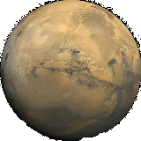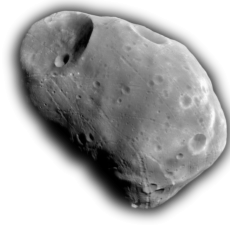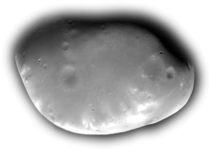The hurtling moons of Mars!
Mars has two small moons, which are almost certainly captured objects from the asteroid belts. They were discovered by Asaph Hall
one hundred years to the day before I was married. The physical resemblance with two other asteroids, Gaspra and Ida, is quite obvious.
The larger of the two is Phobos. This object has some strange linear markings on its surface. The smaller moon is called Deimos. We have
some pretty detailed images of the surfaces of these moons.



Mars has a radius of 3396 km, which is
approximately one half that of Earth. This gives
the planet about the same surface area as the land
area of Earth.
Mars rotates in 24 hours 37 minutes at the sidereal rate,
referenced to the stars. Its synodic day, from noon to
noon, is 24 hours 39 minutes. This is very near Earth’s
rate of rotation. The day on the surface of Mars would
seem very familiar to an earthling.
Mars orbits the Sun at an average distance of 5.2
A.U. and takes 1.87 years to complete one
revolution. Because of its axial tilt, it has seasons,
just as Earth. But each of its seasons is about
twice as long.
The atmosphere of Mars consists of 96%
carbon dioxide. The remaining 3% is mostly nitrogen.
The pressure at the surface varies from from 4.0 to 8.7
mb (depending on season). We occasionally see clouds
in Mars' thin atmosphere.
Since it lacks an appreciable iron core, Mars has
no self-generated magnetic field. This results in
radiation levels at the surface that would be
harmful for human beings.
Foolish Earthling! Mars has no rings!




















































